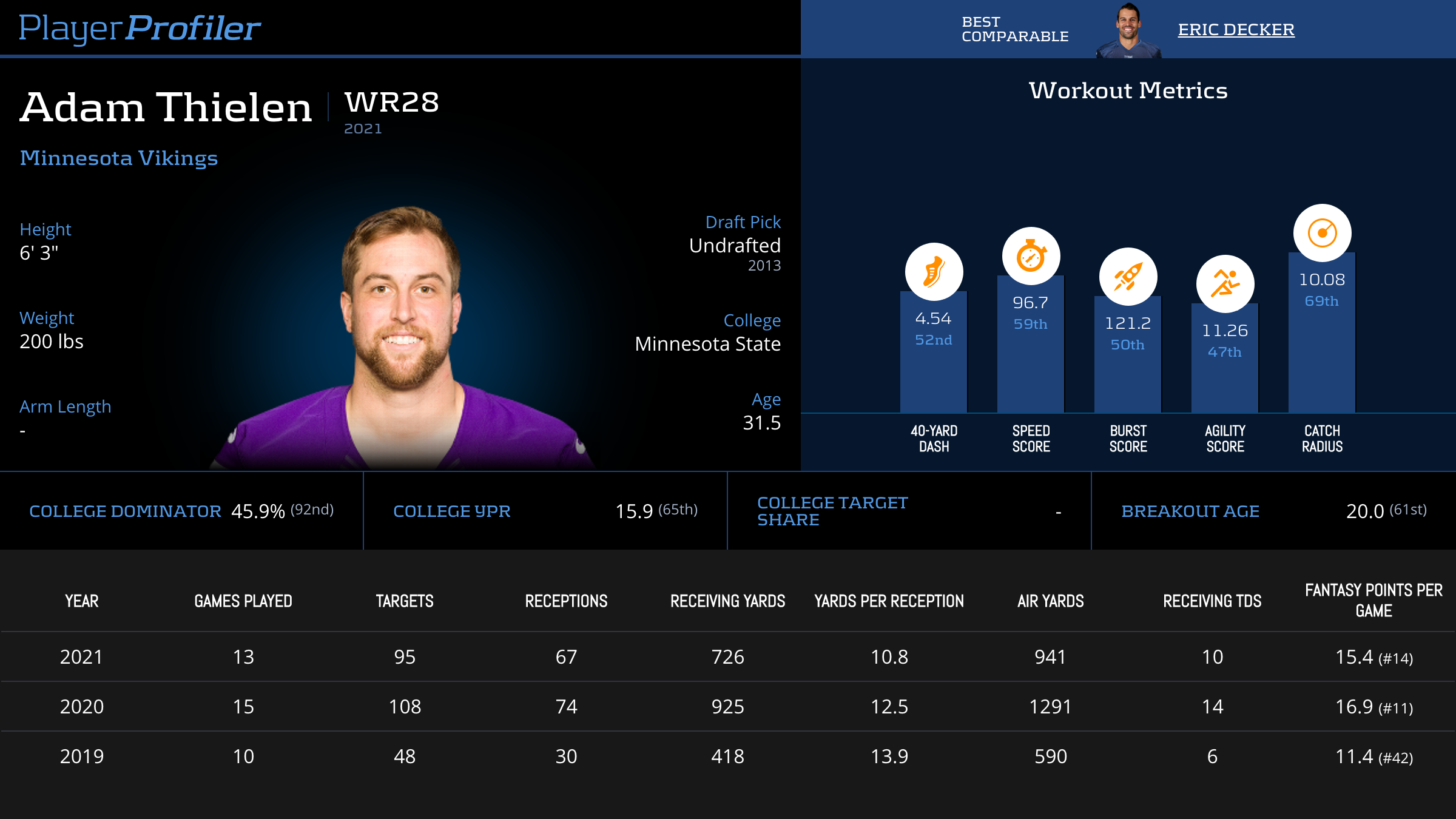Eagle-eyed regular visitors to PlayerProfiler would have noticed over the last few weeks that our player pages have begun to display a brand new metric. You can’t miss it because it’s in the first efficiency section. It’s called “Formation Adjusted Yards per Route Run.” Sounds exotic, and quite a mouthful, doesn’t it? But what exactly is it? It’s time to Meet the Metric.
What is it?
The idea of tracking and showcasing this particular metric came from a rare in-person meeting of the PlayerProfiler Brain Trust in Las Vegas. It should surprise no one that the discussion was an argument with Nate Liss on one side valiantly arguing a point against a determined opposition on the other side of the table. But the idea wasn’t born out of a furious exchange of views between Nate and Matt Kelley, Cody Carpentier, Alex Dunlap, and pretty much everyone else on the team (except those of us that reside in the UK and weren’t invited, but those people are not IN THE SLIGHTEST BIT BITTER). Oh no.
For quite some time, the metric of Yards per Route Run (YPRR) has been used as a measure of efficiency especially with regard to wide receivers. This figure looks at how many routes a player runs and divides their total receiving yards by this number. It’s a much better way of judging efficiency than yards per reception. This can be bloated by players running few snaps and picking up chunk gains. But Yards per Route Run this requires deeper context.
Hayden Winks of Underdog Fantasy was one of the first to note the bias towards wide receivers who played in mostly two wide receiver sets against those in three-wide receiver sets. When there are fewer pass-catching options on a field, a player is likely to be able to post greater efficiency numbers when he commands a target. This has led some to track Personnel Adjusted Yards per Route Run, a metric favored by Nate Liss. However, the brains tracking the data for Player Profiler believed that Formation Adjusted Yards per Route Run do a better job of truly telling the tale of the tape.
Working it All Out
The boffins at Player Profiler HQ used data from 2020 and 2021 to chart players’ alignments on the field and the personnel groups they played in to calculate the expected yards per route run for different alignments in each specific personnel package. They found that the expected YPRR for a slot receiver in 11 personnel (one running back, one tight end, and three wide receivers) is 1.696. Lining up outside the numbers in 21 personnel (two backs, a tight end, and two wide receivers) shoots up to 2.66. The hard work did not stop there, of course. Every wide receiver’s routes were checked to calculate individual expected YPRR. This figure would then be subtracted from their actual YPRR to obtain a deviation from the expected figure. This would be added to the league average YPRR baseline to obtain that players’ Formation Adjusted YPRR.
Got all that? Let’s get down to cases to better demonstrate the process, using Minnesota Vikings wide receiver Adam Thielen as an example.
Taking a Closer Look
In 2021, Thielen’s expected YPRR was a fairly healthy 1.89. His actual YPRR was just 1.74. So taking the first figure from the second gives Thielen a deviation of -0.14. The league average YPRR in 2021, according to our numbers, was 1.65. So by “adding” the deviation, we arrive at Thielen’s formation adjusted YPRR of 1.50. This was “good” for No. 52 among the 96 wide receivers with at least 250 routes run in 2021.
At the top end of the scale, Cooper Kupp led the way with 3.32 YPPR and also with 3.29 Formation-Adjusted YPPR. Deebo Samuel, Davante Adams, Ja’Marr Chase, and A.J. Brown round out the top five in FAYPPR. At the other end, one name stands out for the sheer number of routes he actually ran. Robby Anderson ranked No. 7 among all wide receivers with 567 routes run in 2021. He was WR27 in terms of expected YPRR, but he ended up with just 0.91 which was the No. 9-lowest among qualifying wide receivers. At 0.80, his FAYPPR was No. 93 of 96.
Best and Worst Units
It should stand the Eagles’ passing game, and Jalen Hurts in particular, has two of the best players in terms of FAYPPR on their roster this season. Devonta Smith was No. 11 with 2.11 FAYPPR as a rookie, and his new teammate, A.J. Brown, was up at No. 5 with 2.59. This should more than make up for the fact that their 2020 first-round draft pick Jalen Reagor was No. 92 in expected (1.63), No. 93 in actual (0.81), and No. 89 in FAYPPR (0.82). But while the Eagles can boast two of the top performers, the Panthers have some of the worst performers in this metric on their 2022 roster. Terrace Marshall (0.53), Anderson (0.80), and free-agent signing Rashard Higgins (0.95) take up three of the bottom ten spots.
Until we meet again.




